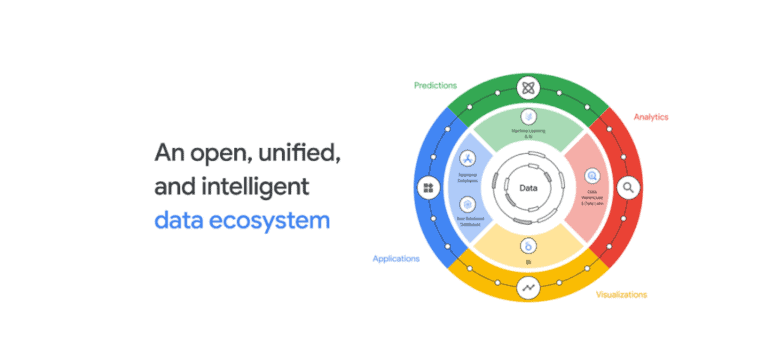Google Cloud has great ambitions for optimizing its cloud strategy. The public cloud giant announced a deluge of updates to its data services at the Google Cloud Next 2022 event.
Google Cloud says it aims to deliver the most open, scalable and powerful cloud environment available. The organization wants to help customers access and process all the data they can. In doing so, the data’s source, location and format should be irrelevant. If it were up to Google Cloud, all customers had access to a complete data ecosystem forming the basis of all business activities.
BigQuery
The first step in this ambition is to ensure that businesses can use all of their data. To this end, Google Cloud announced a number of updates to BigQuery, its data warehouse environment. This service can now analyze unstructured streaming data. The storage format or data source is irrelevant, as all variants are supported. Customers can use analyzed data for applications like machine learning, speech recognition, translation, text processing and data analytics via the Structured Query Language interface.
Data formats now supported by the Big Lake storage engine are Apache Iceberg, Delta Lake and Apache Hudi. The Big Lake storage engine helps manage data in different cloud environments. Google Cloud aims to support as many sources as possible.
Furthermore, BigQuery gained a new integration with Apache Spark. This allows data scientists to improve data processing times. In addition, Datastream will be integrated with BigQuery, making it easier to replicate data from sources like AlloyDB, PostgreSQL, MySQL and Oracle databases. In addition, Google is expanding its Dataplex service in hopes of increasing confidence in data. The technology that automates processes is being revamped to improve data quality and lineage.
Consolidating BI tooling
The next step in Google Cloud’s ambition is improving the accessibility of data processing. To this end, Google Cloud will merge its portfolio of business intelligence tools under its Looker portfolio. The merger includes integrating Looker with Data Studio and other BI tools that provide insights into data. Data Studio will henceforth be called Looker Studio.
Looker will also be integrated into Google Workspace, allowing users to access the BI functionality through everyday tools such as Sheets. Additionally, Looker will soon be able more easily connect to third-party tools, expanding users’ freedom of choice. Upcoming third-party tools include Tableau from Salesforce and Power BI from Microsoft.
AI expansion
Other updates focus on AI functionality. Google Cloud is introducing the Vertex AI Vision service to make AI-based computer vision and image recognition more accessible. The service should further expand the capabilities of Vertex AI, which has been available for some time. The release should create a complete application development environment for ingesting, analyzing and storing visual data. The environment promises to increase the efficiency and speed of computer vision model development.
Google Cloud is also introducing several AI Agents that allow less technical end users to leverage AI models for everyday tasks. For instance, there’s the Translation Hub (an AI Agent for translations) and the Document AI Workbench (an AI Agent for developing customizable document parsers). These can be used to generate summaries of large documents. The advent of Document AI Warehouse should help tag and extract data from documents.
Other integrations
Last but not least, Google Cloud announced the arrival of new integrations with third-party applications and platforms, including connectors for Collibra, Databricks, Elastic, FiveTran, MongoDB, Reltio and Strimm.
Tip: Google Cloud partners with cryptocurrency exchange Coinbase
